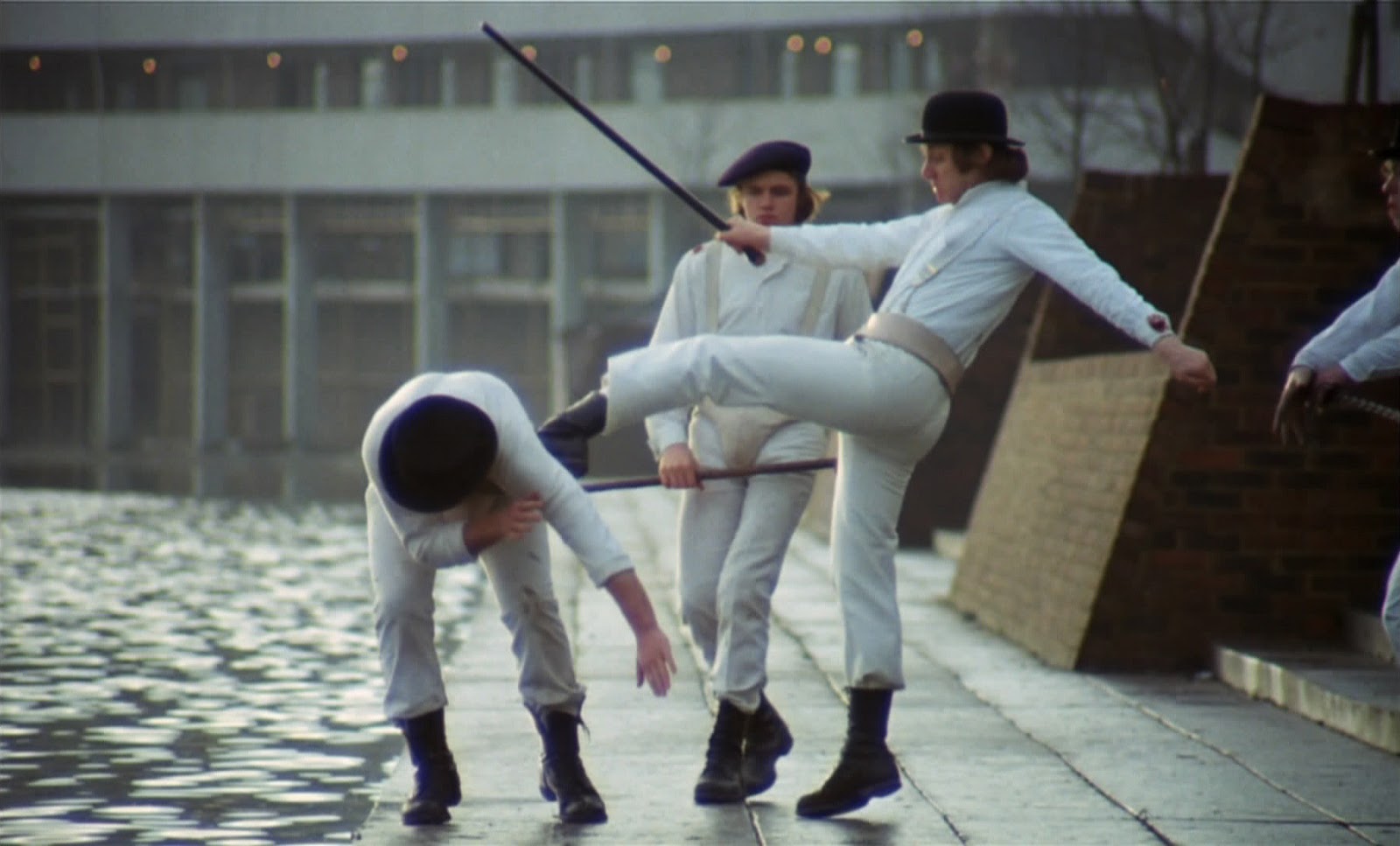The Clockwork Orange Bedroom Scene

The bedroom scene in Stanley Kubrick’s “A Clockwork Orange” (1971) is a pivotal moment in the film, offering a glimpse into the protagonist Alex’s psyche and the dystopian world he inhabits. This scene is visually striking and laden with symbolism, contributing significantly to the film’s overall themes of violence, control, and the nature of good and evil.
The Symbolism of Color
The color palette used in the scene plays a crucial role in establishing the mood and atmosphere. The dominant colors are red and white, creating a stark contrast that reflects the duality present in Alex’s character and the world he inhabits.
- Red: The color red is associated with violence, passion, and aggression. It is prevalent throughout the scene, from the blood-red walls to the red furniture and the red-stained floor. This color reinforces Alex’s violent tendencies and the brutality that pervades his world.
- White: White, on the other hand, symbolizes purity, innocence, and sterility. It is present in the white sheets on the bed, the white ceiling, and the white walls in the bathroom. This color contrasts sharply with the red, suggesting a yearning for something beyond the violence and chaos that surround Alex.
The Use of Light and Shadow
The scene is bathed in a stark, artificial light that creates harsh shadows, contributing to the overall feeling of unease and claustrophobia. This stark lighting highlights the contrast between light and dark, symbolizing the struggle between good and evil within Alex. The shadows also serve to emphasize the grotesque nature of the violence, making it even more disturbing and unsettling.
The Significance of Objects
The objects present in the scene are carefully chosen and serve as visual metaphors for Alex’s personality and the themes of the film.
- Furniture: The furniture in the room is both luxurious and brutal, reflecting Alex’s contradictory nature. The red velvet chairs and the ornate table suggest a desire for comfort and indulgence, while the heavy, imposing furniture suggests a sense of power and dominance.
- Artwork: The artwork in the room is a collection of violent and disturbing images, further reinforcing Alex’s fascination with violence and his distorted view of the world. The paintings depict scenes of torture, murder, and sexual assault, reflecting the darkness that pervades his mind.
- Religious Iconography: The presence of religious iconography, such as the crucifix and the statue of the Virgin Mary, adds a layer of complexity to the scene. This iconography suggests a yearning for redemption and a desire to escape the cycle of violence. However, the way these symbols are presented – often juxtaposed with violent imagery – suggests that Alex’s understanding of faith is twisted and distorted.
The Scene’s Connection to the Themes of Violence and Control

The bedroom scene in *A Clockwork Orange* is a pivotal moment in the film, offering a glimpse into Alex’s psyche and showcasing the themes of violence and control that permeate the narrative. The scene reveals Alex’s violent tendencies through his interactions with the other characters and the objects in the room, while also highlighting his attempts to exert control over his environment and the people around him.
Alex’s Violent Tendencies
The scene depicts Alex’s violent tendencies in a chillingly matter-of-fact manner. He engages in acts of violence against his friends, Dim and Georgie, with a disturbing lack of remorse. The scene’s portrayal of violence is not simply gratuitous; it serves to illustrate the extent of Alex’s depravity and his inability to empathize with others. Alex’s violence is also evident in his interactions with objects in the room. He throws a chair at Dim, kicks a record player, and smashes a glass of milk, demonstrating a disregard for property and a tendency towards destructive behavior. The scene’s starkness and Alex’s casual cruelty contribute to the film’s overall unsettling tone.
Alex’s Attempts to Control
Alex’s desire for control is a defining characteristic. He strives to maintain dominance over his friends, often resorting to violence and intimidation to enforce his will. His interaction with Dim and Georgie illustrates this. Alex’s violent outburst towards Dim is a direct response to Dim’s attempt to assert his own opinion, highlighting Alex’s intolerance of any challenge to his authority. Alex’s control extends beyond his immediate circle. He seeks to control his environment, engaging in activities like playing classical music and engaging in sexual violence, which are all attempts to impose his own twisted sense of order on the world around him.
Comparison to Other Scenes, Clockwork orange bedroom scene
The bedroom scene’s portrayal of violence stands in stark contrast to other scenes in the film. For instance, the scene where Alex is subjected to the Ludovico treatment, which seeks to eliminate his violent tendencies, showcases the consequences of control and manipulation. The scene highlights the dangers of attempting to control human behavior through external means, as it ultimately leads to Alex’s psychological breakdown. The bedroom scene also contrasts with the final scene of the film, where Alex is presented as a reformed individual, suggesting that the cycle of violence can be broken, but only through genuine change and introspection.
The Scene’s Role in the Film’s Overall Narrative: Clockwork Orange Bedroom Scene

The bedroom scene in “A Clockwork Orange” is more than just a depiction of Alex’s violent tendencies; it serves as a pivotal moment in the film’s narrative, setting the stage for the central themes and conflicts that will unfold throughout the story. It is through this scene that we gain insight into Alex’s character, his motivations, and the complex moral dilemmas that drive the film’s narrative.
The scene’s significance lies in its ability to introduce the core themes of the film: violence, control, and the nature of free will. It reveals Alex’s violent tendencies and his fascination with inflicting pain, establishing the film’s exploration of the dark side of human nature. It also showcases Alex’s sense of control over his environment and his belief in his own superiority, highlighting the film’s exploration of the dangers of unchecked power.
The Scene’s Contribution to Alex’s Character Arc
The bedroom scene is crucial in understanding Alex’s character arc. It reveals his deeply ingrained violent tendencies and his lack of remorse, painting a picture of a young man who finds pleasure in inflicting pain on others. This scene sets the stage for Alex’s journey, which will involve him facing the consequences of his actions and grappling with the complexities of free will and control. The scene’s graphic depiction of Alex’s violence serves as a stark contrast to his later transformation, emphasizing the impact of the Ludovico treatment on his personality and highlighting the film’s exploration of the ethical implications of controlling human behavior.
The Scene’s Impact on the Film’s Overall Tone and Atmosphere
The bedroom scene sets the tone and atmosphere for the rest of the film. Its graphic depiction of violence creates a sense of unease and tension, foreshadowing the dark and unsettling world that Alex inhabits. The scene’s unsettling nature contributes to the film’s overall feeling of moral ambiguity, challenging the audience to question the nature of good and evil and the boundaries of acceptable behavior. The scene’s disturbing imagery also serves to heighten the film’s sense of dystopia, reflecting a society where violence and chaos reign supreme.
